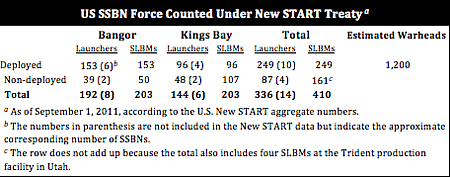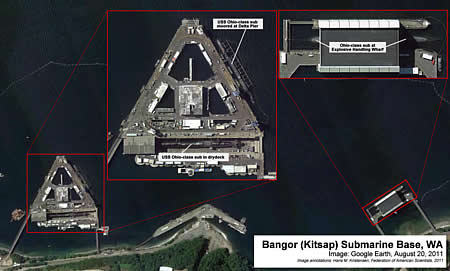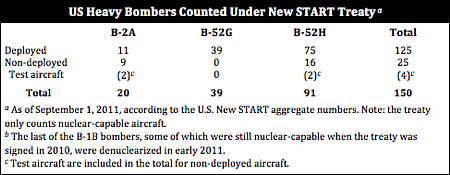 |
| The Obama administration gets a medal for disclosing its New START treaty numbers. |
.
By Hans M. Kristensen [updated 12 Dec 2011 with new bomber information]
Anyone familiar with my writings knows that I don’t hand out medals to the nuclear weapon states very often. But the Obama administration deserves one after the U.S. State Department’s recent release of the full U.S. aggregate data under the New START treaty.
The release breaks with the initial practice under the treaty of only publishing overall nuclear force category numbers, and re-establishes the U.S. practice from the previous START treaty of providing maximum disclosure of the strategic forces counted by the treaty. This is a good development that has gone totally unnoticed in the news media.
The pressure is now squarely on Russia to follow suit and publish its New START aggregate data as well.
Overall Posture
The New START data attributes 1,790 warheads to 822 deployed ICBMs, SLBMs, and heavy bombers as of September 1, 2011. A large number of non-deployed missiles and launchers that could be deployed are not attributed warheads.
The data shows that the United States will have to eliminate 243 launchers over the next six years to be in compliance with the treaty by 2018. Fifty-six of these will come from reducing the number of launch tubes per SSBN from 24 to 20, roughly 80 from stripping B-52Gs and nearly half of the B-52Hs of their nuclear capability, and destruction of 100 ICBM launchers.

The released data does not contain a breakdown of how the 1,790 deployed warheads are distributed across the three legs of the Triad. But because the bomber number is now disclosed (each bomber counts as one warhead) and because roughly 500 warheads remain on the ICBMs, it is possible to make an estimate of the number of warheads deployed on the ballistic missile submarines: approximately 1,200 warheads, or two-thirds of the total count under New START.
Ballistic Missile Submarines
The New START data shows that the United States as of September 1, 2011, had 249 Trident II SLBMs onboard its SSBN fleet. Each SSBN has 24 missile tubes for a maximum loadout of 288 missiles, but at the time of the New START count three SSBNs were empty and one partially loaded. With an estimated 1,200 warheads on the SLBMs, that translates to an average of 4-5 warheads per missile.

The assumption is normally that 12 out of 14 SSBNs are deployed, with the remaining two in overhaul at any given time. But the New START data illustrates that the force ready for deployment sometimes is smaller, in this case only 10 SSBNs. Other information shows that this ratio fluctuates significantly, and in average 64 percent (8-9) of the SSBNs are at sea with roughly 920 warheads. Up to five of those subs are on alert with 120 missiles carrying an estimated 540 warheads. That’s enough to obliterate every major city on the face of the earth.
The SSBN fleet conducted 33 deterrent patrols last year, with each operational SSBN sailing on three patrols per year, each lasing 70-100 days. That’s a very high operational tempo, comparable to that of the Cold War.
The bulk of the SSBN fleet is based at Bangor (Kitsap) Submarine Base in Washington. Eight subs are homeported at this base, and the New START data shows that two were out of commission on September 11, 2011: one had empty missile tubes – possibly because it was in dry dock – and another was only partially loaded – possibly because it was in the middle of a missile exchange when the count occurred. This means that six of eight SSBNs at the base were loaded with Trident II D5 missiles at the time of the New START count.
A satellite image taken on August 20, 2011, only 11 days before the New START data count, shows three Ohio-class subs present at Bangor, including one in dry dock and another at the Explosives Handling Wharf. (see figure below).
 |
| Three SSBNs were present at Bangor Submarine Base on August 20, shortly before the New START count. Click on image for full size. |
.
The same image also shows two Ohio-class subs at Puget Sound Naval Shipyard at Bremerton, Washington, only a few miles away. One of the two is an SSGN, a former SSBN stripped of its nuclear missiles and converted to carry cruise missiles and special forces. The other appears to be an SSBN. The New START data does not reflect two entirely empty SSBNs on the west coast, so either one of them was loaded with missiles between the time of the satellite image and the New START count, or the SSBN at Puget Sound Naval Shipyard is from Kings Bay.
The remaining five Bangor-based SSBNs that were at sea the day the image was taken carried 120 missiles with an estimated 540 warheads. Three of those were on alert with 72 missiles and roughly 325 warheads.
In the Atlantic, six SSBNs are based at Kings Bay Submarine Base in Georgia, a significant change from the Cold War when most U.S. SSBNs were homeported on the east coast. Two of the six subs did not carry missiles on September 1, 2011, leaving a deployable force of four SSBNs carrying 96 missiles with an estimated 430 warheads.
The New START data shows that the U.S. Navy has not yet begun to reduce the number of missile tubes on each SSBN. The Pentagon has stated that the number of missile tubes on each submarine will be reduced from 24 to 20 before the New START enters into force in 2018.
Intercontinental Ballistic Missiles
The New START data shows that the United States deployed 448 Minuteman III ICBMs as of September 1, 2011. Most were at the three launch bases, but a significant number were in storage at maintenance and storage facilities in Utah. That included 58 MX Peacekeeper ICBMs retired in 2003-2005 but which have not been destroyed.

The New START data does not show how many warheads were loaded on the 448 deployed ICBMs, but the number is thought to be approximately 500. The 2010 NPR decided to “de-MIRV” the ICBM force, an unfortunately choice of words because the force will be downloaded to one warhead per missile, but retain the capability to re-MIRV if necessary.
Heavy Bombers [updated 12 Dec 2011 with new B-1 information]
The New START data shows that the U.S. Air Force possessed 152 B-2 and B-52 bombers as of September 1, 2011. Of these, 125 were counted as deployed. The disclosure of the bomber count breakdown is important because it has been unclear how many bombers were actually counted by the treaty. The count includes B-52G bombers that are not used for nuclear missions, but still carry equipment that makes them accountable under the treaty. The last of the B-1s that were still nuclear capable when the treaty was signed were denuclearized in early 2011.

Of the 20 B-2s and 93 B-52s, 18 and 76 (a total of 94), respectively, are nuclear-capable. But only about 60 those are thought to be nuclear tasked at any given time. Stripping excess B-52Hs and the remaining B-52Gs of their nuclear equipment will be necessary to get down to 60 nuclear-capable bombers by 2018.
Heavy bombers do not carry nuclear weapons under normal circumstances, but a few hundred warheads are thought to be stored at the three bomber bases. In addition, hundreds of additional bomber warheads are in central storage. Overall, some 1,000 bombs and cruise missiles are thought to be earmarked for use by the bombers. The NPR states that bombers (along with SSBNs) play an important role in warhead upload scenarios.
Conclusions and Recommendations
The State Department’s release of the full U.S. aggregate data under the New START treaty deserves credit because it increases transparency of U.S. nuclear forces and restores the practice under the previous START treaty of disclosing such information to the public.
After the New START treaty was signed in April 2010 and entered into force in February 2011, it first appeared as if this information would not be released. I warned against this in March, and in May, three former U.S. officials joined FAS in urging the United States and Russia to disclose the full aggregate data.
The first New START aggregate data from February (released in June) did not follow the advice; only six overall numbers were disclosed. The new release of the full September data corrects that mistake.
In context, the data release is extra impressive because it follows the release of other important nuclear information by the United States over the past 18 months, most importantly the disclosure in May last year of the size and history of the total nuclear warhead stockpile and warhead dismantlement.
Following all of this, a clear responsibility now rests on Russia to follow suit and begin to lift the veil for its nuclear arsenal as well. Russia generally discloses very little about its nuclear forces and is falling behind Britain, France, and the United States in transparency. Andrei Nesterenko from the Russian foreign ministry stated in May 2010 that after the New START treaty “comes into force, we will also be able to consider practically the issue of publishing the total amount of deployed strategic carriers and…warheads.”
Well, now the treaty is in force, and with the Preparatory Committee for the nuclear Non-Proliferation Treaty (NPT) – the so-called NPT PREPCOM – coming up in early May 2012, the next few months would be a good time for Russia to follow the U.S. lead and release the full New START aggregate numbers.
After all, if the Kremlin can share this information with the Pentagon, what’s the point in denying it to the rest of the world?
This publication was made possible by a grant from Carnegie Corporation of New York and Ploughshares Fund. The statements made and views expressed are solely the responsibility of the author.
The Federation of American Scientists applauds the United States for declassifying the number of nuclear warheads in its military stockpile and the number of retired and dismantled warheads.
North Korea may have produced enough fissile material to build up to 90 nuclear warheads.
Secretary Austin’s likely certification of the Sentinel program should be open to public interrogation, and Congress must thoroughly examine whether every requirement is met before allowing the program to continue.
Researchers have many questions about the modernization of Pakistan’s nuclear-capable aircraft and associated air-launched cruise missiles.